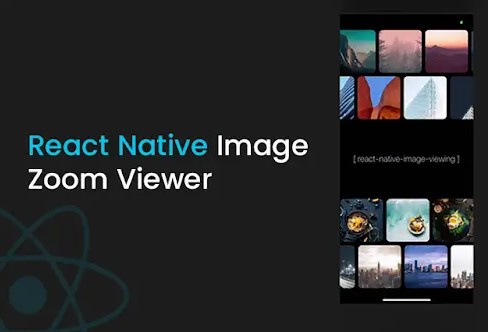Do you want to explore the process of implementing pinch-to-zoom using the React Native Image Zoom Viewer? If yes, then go through this guide thoroughly and find the process involved in such an implementation task.
Currently, mobile apps play a major role in this world and it has become very useful in everyone’s day-to-day life. There is a huge demand for user-friendly and intuitive interfaces that offer a better user experience from e-commerce apps to social media platforms.
By considering such factors, many mobile apps can effectively zoom in on images for the closer look. Read this guide further to know the process of implementing pinch-to-zoom functionality using the React Native Image Zoom Viewer. A React Native Image Zoom Viewer is the powerful library that adds such features very effectively to the React Native application.
If you are developing an ecommerce app that lets users zoom in on a photo sharing app or on product images where users can explore high definition images, implementing pinch-to-zoom functionality is very much essential to improve satisfaction and user engagement.
Why React Native?
React Nativeis very popular among developers since it can develop cross platform mobile apps with the single codebase. It lets developers write the code in react and JavaScript that can be compiled into the native code for android and iOS platforms. It will completely reduce the development effort & time, making it the great choice for businesses to reach their target audience with their mobile applications.
React Native provides a wide range of components and libraries while adding challenges features like pinch-to-zoom to simplify the process. React Native Image Zoom Vieweris the best library that offers the most effective ways to implement the pinch-to-zoom functionality in mobile applications.
Impact of React Native Image Zoom Viewer:
At first, you must start the process by setting up the React Native project & installing the required dependencies before getting into the implementation details.
Step 1: Create the New React Native Project
Use this code npx react-native initZoomApp to create the new React Native project.
Step 2: Install React Native Image Zoom Viewer
After setting up the project, move to the project directory & install the React Native Image Zoom Viewer package using yarn or npm:
npm install react-native-image-zoom-viewer –save
Step 3: Link Native Dependencies
React Native Image Zoom Viewer is based on the native dependencies and hence you must need to link everything to your project. Use npx react-native link react-native-image-zoom-viewer to link the native dependencies without any issues.
You can start implementing the pinch-to-zoom functionality in the React Native app with the required dependencies.
Implementing Pinch-to-Zoom with React Native Image Zoom Viewer
Here you can explore some examples for demonstrating the process using React Native Image Zoom Viewer to enable pinch-to-zoom in your app. In this example, it is assumed that you have the image and want to make it zoomable.
Step 4: Import & Configure React Native Image Zoom Viewer
In the app’s JavaScript code, import the required component and configure the ImageZoomViewer component with the images that you want to display:
import React from ‘react’;
import { View, Image } from ‘react-native’;
importImageViewer from ‘react-native-image-zoom-viewer’;
const images = [
{
url: ‘https://example.com/image1.jpg’,
},
{
url: ‘https://example.com/image2.jpg’,
},
// Add more images as needed
];
function App() {
return (
<View style={{ flex: 1 }}>
<ImageViewerimageUrls={images} />
</View>
);
}
export default App;
From the above code, you can see that the ImageViewer component is imported from the ‘react-native-image-zoom-viewer’ package & configured with the group of images to display. Each image included in the array is specified with a separate URL.
Step 5: Style and Customise
Further you can customise the behaviour and appearance of the ImageZoomViewercomponent to match the app’s design. React Native Image Zoom Viewer offers many props that let you control major aspects like zooming style, behaviour and much more.
Take a look at below to explore the best example of customising the component:
ImageViewer
imageUrls={images}
enableSwipeDown={true}
onSwipeDown={() => console.log(‘User swiped down’)}
style={{ backgroundColor: ‘black’ }}
renderHeader={() => (
<Text style={{ color: ‘white’ }}>Custom Header</Text>
)}
In the above code, swipe-down is enabled to dismiss the image viewer, added the custom header &changed the background color to black.
Step 6: Run the App
After implementing & customizing the ImageZoomViewer component, you can run the React Native app to execute pinch-to-zoom in action:
npx react-native run-android # for Android
npx react-native run-ios # for iOS
Now the app should display the images with proper pinch-to-zoom functionality, offering users with the better way to zoom in & explore the images in detail.
Incorporating the pinch-to-zoom functionality into the React Native app can improve the app engagement and user experience to the next level. React Native Image Zoom Viewersimplifies the implementation process that lets you focus more on providing the most extraordinary user experience.
If you are developing an ecommerce app, any other mobile app or a photo-sharing platform that consists of displaying images, then sure React Native Image Zoom Viewer can be the most valuable tool for you. It can save your effort and time by offering a simple way to implement the essential feature and ensure that the app meets the expectations of mobile users.
Conclusion:
From the above mentioned scenario, now you have discovered that React Native Image Zoom Viewer is the powerful library that simplifies the functionality of pinch-to-zoom in React Native applications. Hence follow everything mentioned in this guide to integrate this feature quickly into your app. It can improve your user experience & make your app more useful to users.
When you need any help or support for implementing pinch-to-zoom functionality using the React Native Image Zoom Viewer, then sure you can hire react developer. Hiring these skilled developers can let you succeed in the React Native project without any issues. There are a wide range of benefits you can explore while getting help from these developers. Their support can also let your mobile app project to get a better reach.
If you are going to hire a React Developer, then ensure that they have more experience and expertise to deliver the better results to meet your business goals.


No comments yet